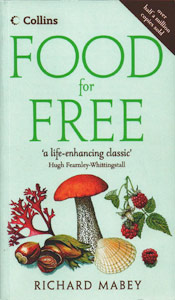
| HOME |
| NERVE |
| REVIEWS |
| ARCHIVE |
| EVENTS |
| LINKS |
| ABOUT US |
| CONTRIBUTORS |
| BACK ISSUES |
| CONTACT US |
 Food
for Free
Food
for Free
By Richard Mabey
Published by Collins, £12.99
Reviewed by Sue Hunter
This book was first published in 1972, followed by a full colour edition in 1989, and now a new edition in 2007.
Through these 25 years Food for Free has become a classic, used and loved by countless people from town and country. It is a guide to foraging for wild food in the British countryside, but is so much more than that.
The author describes each plant, where to find it and how to enjoy it at its best. Sometimes he includes a recipe, often of ancient tradition, some sent in by readers. He also tells the history of each food item and its place in rural life. All are accompanied by clear, beautiful colour illustrations by a variety of artists. Included are plants, trees, fungi, lichens, seaweeds and shellfish.
Here is an example to give a flavour of the book: “Fat-hen (chenopodium album): common in cultivated and waste ground throughout Britain. An undistinguished plant, 20-150 cm (8-60 inches) tall, with stiff upright stems and diamond –shaped greyish-green leaves. Flowers June to September, pale green, minute and bunched into spikes.
“Fat-hen is one of those plants that thrive in the company of humans… It is one of the very first plants to colonise ground that has been disturbed by roadworks or house-building, its stiff, mealy spikes often appearing in prodigious quantity. No wonder that its use as a food plant dates back to prehistoric times. Remains of the plant have been found in Neolithic settlements all over Europe. The seeds also form part of the last, possibly ritual meal fed to Tollund Man (whose perfectly preserved corpse, stomach contents included, was recovered from a bog in Denmark in 1950).
“In Anglo-Saxon times the plant was apparently of sufficient importance to have villages named after it. As melde it is thought to have given its name to Melbourn in Cambridgeshire and Milden in Suffolk. The introduction of spinach, a domesticated relative, largely put an end to the use of the plant, but its leaves continued to be eaten in Ireland and the Scottish islands for a long while, and in many parts of Europe during the famine conditions of the Second World War. We now know that early people were lucky in their choice of fat-hen as a staple vegetable, for it contains more iron and protein than either cabbage or spinach, and more vitamin B1 and calcium than raw cabbage.
“The whole plant can be eaten raw, but it is probably best prepared and cooked in the same way as spinach, as a green vegetable, or in soups. It is pleasantly tangy, like young kale or broccoli.”
This quote illustrates Richard Mabey’s holistic approach; it also gives us practical information for potentially hard times ahead. Foraging has now become fashionable, being promoted by certain celebrity chefs, and Mabey warns of the danger of over-exploitation. Food for Free has always been popular not just for helping people get back in touch with Nature, but also for encouraging conservation of precious resources.
Richard Mabey has a deep knowledge of our Flora and Fauna, and for decades has researched their history and biology, writing other classic works such as Flora Britannica. But his writing is never dry or boring; it is poetic and moving without being sentimental, as his care and feeling for our natural heritage shines through.